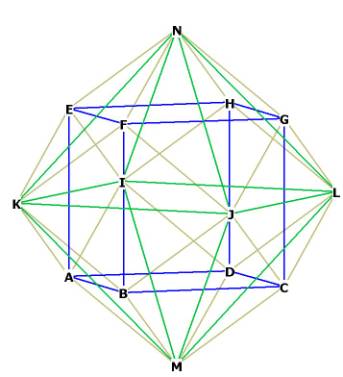|
(2017
midterm assignment) Model Student Midterm answers 2017 (Index) Essay 3: Web Highlights |
 |
Kerisha Loctor
November 6, 2017
Merging of Future Narratives
The
more common models of future narratives (the creation/apocalypse model, the
evolution model, and the alternative future model) are usually discussed
separately from one another. The creation/apocalypse model refers to a story
that starts with a creation of a world and ends with the destruction of said
world with the promise of a new world. The evolution model is based off the idea
of species and environment evolving from what is considered normal. The
alternative future is based off a branching storyline that comes from one or
many points and changes due to events in the story. Separately, the narrative
models do seem different; however, these models can complement each other. These
narratives also all tend to end the same way, with the main characters
discovering a truth about themselves and the world. Most of these narratives
also tend to end with the cessation of mankind’s existence.
In her essay, “The Power of Three”, Kimberly Hall emphasized the patterns
found within each future narrative. Kimberly Hall also believes that “the three
different narratives—creation/apocalypse, evolution, and alternative future—may
occasionally clash, but under the right circumstances can work harmoniously.”
She described in detail each future narrative style, starting with the
creation/apocalypse model, using Scripture and
Parable of the Sower as references.
Hall states, “the timeline is linear, direct, and easy to grasp, with three main
components—creation, to exile, to apocalypse, where rebirth is a possibility but
not a guarantee.” The possibility of rebirth also provides the possibility of
evolution and Hall goes back to this point by stating that
Parable develops into an evolutionary
model as the story progresses.
Nikki
Jones in her essay, “The Three Narratives: Hand-in-Hand,” she makes the same
connection between the creation/apocalypse and evolution models. She described
the main character of Parable,
Lauren, as “always growing, evolving, and adapting to the steady changes that
happen in her life.” Jones also touches on the concept that the evolutionary
model of future narratives can work well with the alternative model. She uses
the text, “Mozart in Mirrorshades” as a reference. The character, Mozart,
evolves within the story while traveling different histories and time. Jones
described Mozart as becoming, “captivated with modern amenities, nicknaming
himself Wolf, learning the English language at a fast pace, and ultimately
abandoning the past to evolve into the men found commonly in Realtime.”
There
are narratives that make use of all three models. In her essay, Kimberly Hall
uses “The Gernsback Continuum” as a reference to this point. The story was told
as an alternative future of the 1930s and ends with the mention that the story’s
present time takes place in a dystopia. Hall mentions the evolution aspect by
pointing out the descriptions of the “flying wing’, a futuristic roadster, and
huge 80-lane freeways” that the main character observed. She also used
The Time Machine as an example of a
text that uses these three models of narratives. Hall states, “Wells’ narrative
itself works in three parts- the past, the present, and the future,” referring
to the fact that the story is being told in present time about a past event
about someone that had travelled to the future.
Another way that these three models parallel each other is in the ultimate
messages that are subtly conveyed throughout the stories; humans are always on
the journey to self-discovery and self-acceptance. In Scripture, according to
Rebecca Dyda in her essay, “Discovering the Truth”, humankind is on the journey
to self-discovery and through the help of God as “he is the reason why we live,
and he is who we will spend our lives living for.” However, at the end of the
Scripture comes chaos and destruction and the end of mankind.
Parable follows the same pattern,
which is an example of the evolution model. Dyda mentions, “the more that Lauren
would learn and find her own truth and disregard the truth of the bible, the
more that this gated community crumbles apart.” The alternative future model,
though subtle, can follow this same pattern of self-discovery. Dyda uses “Better
be Ready at Half Past Eight” as a reference to this concept. Both the main
character, Byron, and Zach challenged their sexual identities and were in the
process of self-acceptance. As support, Dyda states, “both men seem to find some
truth in themselves, ultimately making their own decisions on how to deal with
this truth.”
Most
future narratives end with the characters accepting themselves and worlds as
they are; however, many future narratives end with the destruction of humankind.
In her essay, “Loneliness Likely Awaits Us in the Future,” Meagan Hamlin states
this most accurately, “No matter how much our society advances technologically
or regresses on the evolutionary scale, the future looks bleak according to
literature of the future.” As there is creation, there is the apocalypse, as
seen in popular apocalyptic movies and television series. Species can evolve to
eventually become the dominant species, eventually wiping out or reducing the
human race, as seen in the television series
Zoo. The animals begin to develop a
more cognitive awareness of their environment and begin to take revenge against
the humans that once oppressed them. The alternative future is a flexible model,
but there are future possibilities that can show the possible end of humankind
due to human error.
The
three models of future narrative – creation/apocalypse, evolution, and
alternative futures – are typically used separately in storytelling, but the
models can work harmoniously together. An apocalypse can lead to evolution, and
vice versa. Evolution of different species at different times can make a great
foundation to an alternative futures piece. Future narratives can become more
fascinating as these models are used together, especially in conveying the
messages of self-discovery or warnings of the end of mankind. These narratives,
though they may just be stories of entertainment, according to Hamlin, do offer
a “simple truth and that is “we hold the key to the future, and as a planet we
are less than likely to change our ways in order to aid our future generations.”
 |
 |
 |
